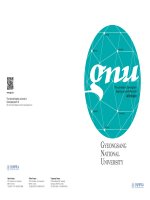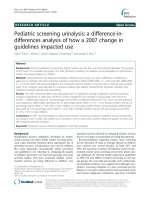LEAD-Pediatric-screening-program-2016
Bạn đang xem bản rút gọn của tài liệu. Xem và tải ngay bản đầy đủ của tài liệu tại đây (323.51 KB, 4 trang )
Li-Fraumeni Syndrome Education and
Early Detection Program (LEAD)
Pediatric Screening Program
People who have Li-Fraumeni syndrome (LFS)
(confirmed by a genetic test report where
germline p53 mutation was found) are at an
increased risk of developing several types of
cancers. Because of this increased cancer risk,
it is important for people with LFS to follow a
comprehensive screening plan to detect cancer
as early as possible.
Different hospitals may have different
screening programs. This document explains
MD Anderson’s LFS screening program for
children and adolescents (under age 20). This
is called the LEAD program.
Words to Know
A genetic counselor will talk to you about
these terms and what they might mean for
you.
Mutation – a change in a person’s genetic
information that results from damage to a cell
or cells. Mutations can be somatic or
germline.
Somatic p53 gene mutation – changes in a
person’s genetic information that can cause a
tumor or cancer to develop. These mutations
are acquired in various cells as a person ages,
has excessive sun or radiation exposure or
long-term exposure to toxic chemicals, etc.
Individuals with a confirmed diagnosis of LFS
Germline p53 gene mutation - changes in a
who should follow the LEAD program include:
person’s genetic information that can cause
People with no personal history of cancer
an increased risk to develop multiple types of
cancer. Individuals are born with a germline
Cancer survivors who are at least 1 year
mutation and that mutation is present in every
past completing active treatment (such as
cell of their body.
chemotherapy and/or radiation)
Cancer survivors who are at least 6 months
past completion of surgery (if surgery was the only treatment for their cancer).
Individuals who may not be eligible for the LEAD program include people:
Who do not have a confirmed diagnosis of LFS by genetic testing
Who are actively being treated for cancer
Whose cancer has spread
Li-Fraumeni Syndrome Education and Early Detection (LEAD) – Pediatric Screening Program
The University of Texas MD Anderson Cancer Center ©2014
Revised 01/2016, Patient Education Office 3952
Page 1 of 4
Screening Exams and Frequency by Age
Patients 0-1 Year Old
Every 6 Months
Complete physical and brain function exam
Ultrasound (US) of abdomen and pelvis
Referral for brain ultrasound at pediatric hospital
A blood draw that will check adrenal gland function and tumor markers. Blood tests can be
completed at an outside facility, if the results are sent to your MD Anderson doctor.
Patients 1-10 Years Old
Every 6 Months
Complete physical and brain function exam
Ultrasound (US) of abdomen and pelvis
A blood draw that will check adrenal gland function and tumor markers. Blood tests can be
completed at an outside facility if the results are sent to your MD Anderson doctor.
Once Per Year (Alternating Every 6 Months)
Each of the screening tests below should be completed once per year, but you will have
screening every 6 months to rotate the different types of screening. For example, if you have a
brain MRI in January, then you should have a whole body MRI in June.
Brain MRI
Whole body MRI (beginning at 2-3 years of age or based on family history or if
recommended by your doctor)
Patients 10-20 Years Old
Every 6 Months: Exams and Review of Body Systems
Complete physical
Brain function
Thyroid gland
Skin
Once Per Year
A blood draw to check adrenal gland function and tumor markers. Blood tests can be completed
at an outside facility if the results are sent to your MD Anderson doctor.
Once Per Year (Alternating Every 6 Months)
The screening tests below should be done once per year, but you will have screening every 6
months to rotate the different types of screening. For example, if you have a whole body MRI in
January, then you should have a brain MRI in June.
Whole body MRI
Brain MRI
Li-Fraumeni Syndrome Education and Early Detection (LEAD) – Pediatric Screening Program
The University of Texas MD Anderson Cancer Center ©2014
Revised 01/2016, Patient Education Office 3952
Page 2 of 4
The screening exam reports may take from a few days up to 1 week to be available. This is
because frequently your doctor and the doctor who performed the exams will need to discuss the
findings. Please note that the exams most likely will detect some variants in your images, but the
majority of these will not be cancer or something that we need to investigate further.
Additional Recommendations for all Children and Adolescents
Learn about the signs and symptoms of leukemia and lymphoma. These may include, but are
not limited to:
Always feeling weak and tired
Losing weight without trying
Enlarged lymph nodes
Excessive sweating
Frequent infections, easy bleeding or bruising, etc.
Learn about the signs and symptoms of adrenocortical tumors (ACT). These may include, but
are not limited to:
Hypertension (high blood pressure)
Cushing syndrome (caused by prolonged hormone exposure in the body and may cause
symptoms such as progressive weight gain and skin changes)
Virilization (typical effects seen in children are growth of pubic hair, accelerated growth
and bone maturation, increased muscle strength and adult body odor before the age
puberty should normally begin)
Learn about the signs and symptoms of brain tumors. These may include, but are not limited
to:
Headaches, vomiting or visual changes
Weakness or sensory changes
Increased sleeping and fatigue
Seizures or abnormal movements
Cognitive decline or personality change
Learn about the signs and symptoms of thyroid cancer. These may include, but are not
limited to:
A lump that can be felt through the skin on your neck
Changes to your voice, including increasing hoarseness
Difficulty swallowing
Pain in your neck and throat
Swollen lymph nodes in your neck
Learn about the signs and symptoms of melanoma. These may include, but are not limited to:
A change in an existing mole (itching, oozing, or bleeding)
The development of a new pigmented or unusual-looking growth on your skin. To help
identify unusual-looking growths think of the letters ABCDE:
A is for asymmetrical shape. Look for moles with irregular shapes, such as two very
different-looking halves.
B is for irregular border. Look for moles with irregular, notched or scalloped
borders. These are signs of melanoma.
Li-Fraumeni Syndrome Education and Early Detection (LEAD) – Pediatric Screening Program
The University of Texas MD Anderson Cancer Center ©2014
Revised 01/2016, Patient Education Office 3952
Page 3 of 4
C is for changes in color. Look for growths that have many colors or an uneven
color.
D is for diameter. Look for new growth in a mole larger than 1/4 inch (about 6
millimeters).
E is for evolving. Any change in color, size, shape; can include bleeding, and itching
Li-Fraumeni Syndrome Resources
LFS Association
www.lfsassociation.org
LFS Association provides information, advocacy and support services for individuals and
families with LFS. They also support researchers, medical providers and caregivers to
further research and promote care for the LFS community.
LivingLFS
/>LivingLFS encourages, educates and empowers individuals living with Li-Fraumeni Syndrome
by connecting them with care, resources and other families diagnosed with LFS.
LFS research study at MD Anderson
www.mdanderson.org/lfsstudy
The Li-Fraumeni Syndrome research study is led by Dr. Louise Strong. It comprises one of the
largest collections of families with LFS in the world. The data and observations collected from
the research participants have contributed much knowledge about this rare syndrome.
More Resources
National Cancer Institute
This site has valuable cancer related health information on more than 200 cancer types, clinical
trials, cancer statistics, prevention, screening, risk factors, genetics and support resources.
American Cancer Society (ACS)
The ACS is a voluntary national health organization that supports research, provides information
about cancer and offers many programs and services to patients and their families.
Li-Fraumeni Syndrome Education and Early Detection (LEAD) – Pediatric Screening Program
The University of Texas MD Anderson Cancer Center ©2014
Revised 01/2016, Patient Education Office 3952
Page 4 of 4









